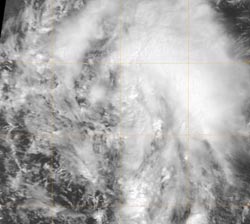NASA sees fifteenth Atlantic tropical depression born

NASA's Terra satellite passed over newborn Tropical Depression 15 on Oct. 3 at 8:52 a.m. EDT in the central Atlantic Ocean.<br><br>Credit: NASA/NRL<br>
NASA's Terra satellite passed over newborn Tropical Depression 15 on Oct. 3 at 8:52 a.m. EDT in the central Atlantic Ocean and the Moderate Resolution Imaging Spectroradiometer (MODIS) instrument captured an image of the storm.
Shortly after the image was created, forecasters at the National Hurricane Center looking at the MODIS and other satellite data determined that the low pressure area had become a depression.
On Oct. 3 at 11 a.m. EDT, the center of tropical depression fifteen (TD15) was located near latitude 17.3 north and longitude 41.5 west, about 1,160 miles (1,870 km) west of the Cape Verde Islands.
The depression is moving toward the northwest near 15 mph (24 kmh) and is expected to turn north and slow down by Oct. 4 before turning to the northeast. TD15's maximum sustained winds were near 35 mph (55 kph). TD15's estimated minimum central pressure was 1008 millibars.
The depression is expected to strengthen into Tropical Storm Oscar later on Oct. 3 or by Oct. 4 and move to the north and northeast. The National Hurricane Center does not expect Oscar to last very long because it is forecast to move into hostile atmospheric territory.
Media Contact
More Information:
http://www.nasa.govAll latest news from the category: Earth Sciences
Earth Sciences (also referred to as Geosciences), which deals with basic issues surrounding our planet, plays a vital role in the area of energy and raw materials supply.
Earth Sciences comprises subjects such as geology, geography, geological informatics, paleontology, mineralogy, petrography, crystallography, geophysics, geodesy, glaciology, cartography, photogrammetry, meteorology and seismology, early-warning systems, earthquake research and polar research.
Newest articles

Superradiant atoms could push the boundaries of how precisely time can be measured
Superradiant atoms can help us measure time more precisely than ever. In a new study, researchers from the University of Copenhagen present a new method for measuring the time interval,…

Ion thermoelectric conversion devices for near room temperature
The electrode sheet of the thermoelectric device consists of ionic hydrogel, which is sandwiched between the electrodes to form, and the Prussian blue on the electrode undergoes a redox reaction…

Zap Energy achieves 37-million-degree temperatures in a compact device
New publication reports record electron temperatures for a small-scale, sheared-flow-stabilized Z-pinch fusion device. In the nine decades since humans first produced fusion reactions, only a few fusion technologies have demonstrated…





















